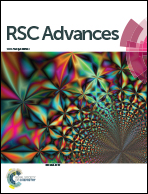Evolution of tubular copper sulfide nanostructures from copper(i)–metal organic precursor: a superior platform for the removal of Hg(ii) and Pb(ii) ions†
Abstract
A wet-chemical reaction strategy has been adopted for the exclusive production of porous copper sulfide using an aqueous solution of copper chloride (CuCl2·2H2O), which acts as a precursor salt, and thioacetamide (TAA) with prolonged standing at room temperature (∼25 °C). The mixed phase copper(I) sulfide with tubular porous morphology has been derived from rod-shaped, white-colored Cu(I) metal organic complex through an auto degenerative hollowing. The importance of chloride ions for obtaining mixed phase copper sulfide has been proved unequivocally. Porous copper sulfide showed outstanding removal efficiency towards two toxic heavy metal ions, i.e. Hg(II) and Pb(II), which certifies the strong interaction between these metal ions and S2− based on the SHAB (soft hard acid base) principle, and a cation exchange mechanism emerges out at the tubular surface as confirmed by various spectroscopic techniques. The as-synthesized product shows removal capacity of 3096 and 2787 mg g−1 for Hg(II) and Pb(II), respectively. Thus, mixed phase copper(I) sulfide stands to be a highly effective substrate for environmental abatement application.


 Please wait while we load your content...
Please wait while we load your content...